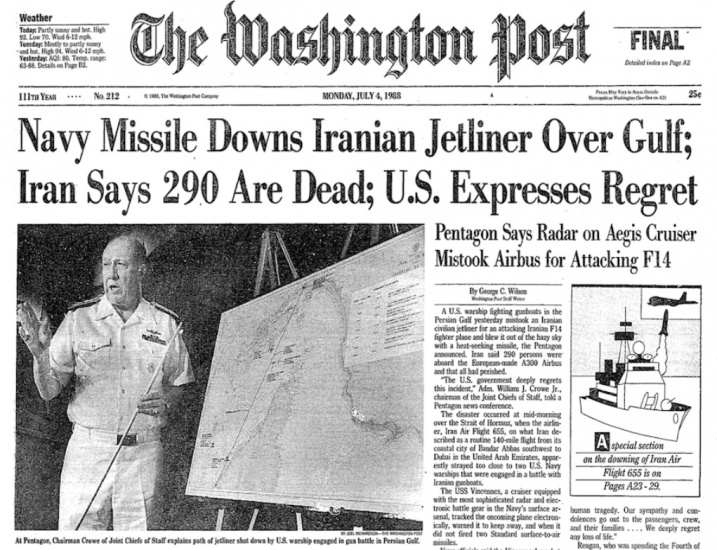July 3, Anniversary of the USS Vincennes Terrorist Attack on Iranian Passenger Plane

The Iranian passenger plane crash is perhaps the gravest type of the US confrontation with the Islamic Republic of Iran, aiming to prop up Saddam Hussein’s regime in his war against Iran. The event unveiled true visage of the US, the so-called advocate of democracy and human rights worldwide.
Iran Air Airbus A300B2, flying based on its routine and regular schedule between Bandarabas and Dubai, was shot down by USS Vincennes in 1988, killing all passengers and crew. Flight 655 took off Bandarabas Airport on July 3rd at 10:17 AM Tehran time. Seven minutes later, 11 seconds after its last radio call with the watch tower, the plane was hit by the US navy Vincennes missiles over the Persian Gulf sky. The attack killed all the 290 people, including 274 passengers and 16 crew, aboard the plane. Some 254 of them were Iranian, 13 from the UAE, 10 Indian, six Pakistanis, six Yugoslavians and one Italian.
The US government claimed that the US navy had mistakenly targeted the Iranian passenger plane as a war plane, so based on the rule of legitimate defense it had the right to defend itself. However, Iran provided ample reasons and evidence that the attack was intentional. Among the reasons is that when hit by the missile of the USS Vincennes navy, the plane was still in the airspace of the Islamic Republic of Iran. The proofs and evidence showed that the US warships were aware of the radio messages of Flight 655– all in English and sent on open frequencies. Evidence and proof have left no doubt that the US government ordered attack on Iranian passenger plane intentionally and fully informed.
The US move once again unveiled the aggressive intention of the US government and its role in making the Persian Gulf region unstable and insecure. Moreover, the event showed that government of the US, as one of the permanent members of the UN Security Council, has failed in its prime duty to guarantee international peace and security. Siding with one of the parties engaged in Iran-Iraq war, the US not only failed to fulfill its commitment but also violated openly the immediate principles of the international rights, practically endangering global peace and security.
Aliakbar Velayati, then the foreign minister of the Islamic Republic of Iran said the US military presence in the Persian Gulf was only the harbinger of death, illegality and mischief, bringing nothing but insecurity; and United States’ criminal act in attacking the Iranian plane was by no means a justifiable legitimate defense. Having heard the speech of then Foreign Minister of Iran Aliakbar Velayati and George Bush in its 3831st meeting on July 30, 1988, the UN Security Council adopted the proposed Resolution 616, whose prelude voiced deep sorrow that an Iranian civilian plane, on its scheduled international flight over Hormuz Strait, was targeted and crashed by a missile fired by the US war navy. The resolution emphasized unbiased inspection in the Persian Gulf so that facts on the incident would be brought into light. Paragraph 5 of the resolution also stressed immediate and full implementation of Resolution 598, which ruled end of the Iran-Iraq war.
After issuance of the UN Security Council resolution and once the issue was raised in the Civil Aviation Organization, the US government paid $55 million USD to families of victims and $40 million to the Islamic Republic of Iran government as reparation for the crash. The reparation paid by the US based on the international law shows that the US has not only admitted the responsibility for the catastrophe but has abided to the incoming point, that is payment of reparation. The question is: Does the reparation compensate all the financial and spiritual damage on the Islamic Republic of Iran? Would it heal injured sentiments of Iranian nation? Answer to the question is difficult indeed. At any rate, the Flight 655 catastrophe is the most important case of violation of the international aviation law and violation of the most basic rules guaranteeing security and safety of international civil aviation.
* Afsaneh Reshad holds a Ph.D. in International Relations. She is also a lecturer at Azad University.

